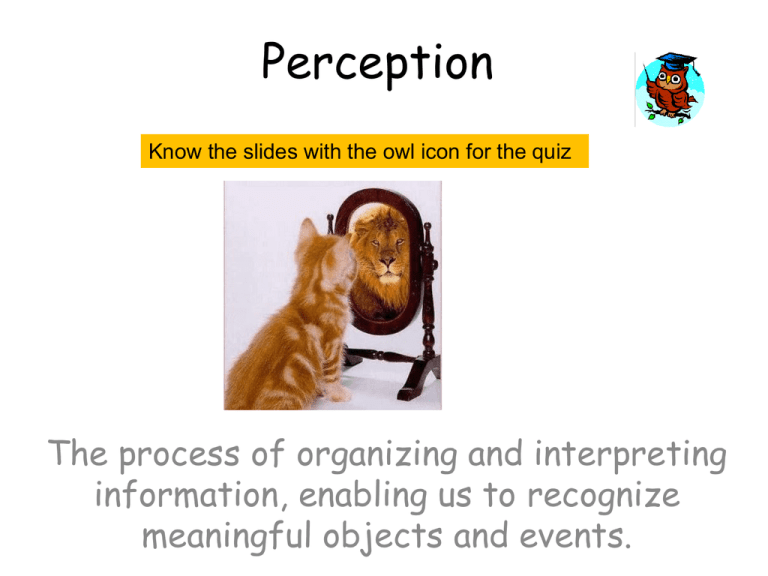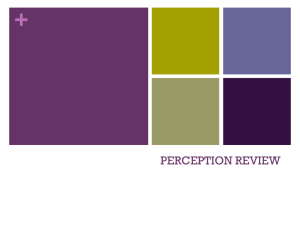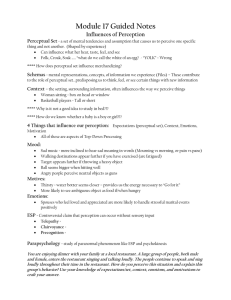Perception in Psychology: Sensation, Attention, and Processing
advertisement

Perception Know the slides with the owl icon for the quiz The process of organizing and interpreting information, enabling us to recognize meaningful objects and events. Sensation • Process of detecting & transmitting energy from the environment to our brain. • Mechanical (physical) • Helps us obtain needed info Perception • Process by which we select, organize, & interpret our sensations • Active & subjective (cognitive) • Depends on many factors Group A • You are going to look briefly at a picture and then answer some questions about it. The picture is a rough sketch of a poster for a costume ball. Do not dwell on the picture. Look at it only long enough to “take it all in” once. After this, you will answer YES or NO to a series of questions. Conclusion • Top Down processing – you go beyond the sensory information to try to make meaning out of ambiguity in your world • What you expect (your experiences and your perceptual set) drives this process • Today we will see what expectations we all have in common. Without ATTENTION, there is no PERCEPTION • We don’t perceive what we don’t attend to! • Attention is selective • Selective Attention: focused awareness on only a limited amt. of a stimulus at any given moment. • The “Cocktail Party Effect” Perceiving the world 1st perceptual task: • We distinguish an object (the figure) from its surroundings (the ground) • Example: » Words (figure) » Page (ground) Reversible Figure-Ground Relationships • Ambiguous, unstable perceptions • Our attention goes back & forth (Selective Attention) • Examples: The Necker Cube and The Rubin Vase The Necker Cube The Rubin Vase Perceiving the world: 2nd perceptual task: • We organize perceptual elements into meaningful patterns. Bottom-up Processing Analysis of the stimulus begins with the sense receptors and works up to the level of the brain and mind. Letter “A” is really a black blotch broken down into features by the brain that we perceive as an “A.” Bottom-up Processing • Perceiving something by focusing on its detailed aspects • Building a complete perception piece by piece (from the bottom up) • “Data-driven processing” Example of Top-Down Processing • Aoccdrnig to rscheearch at Cmabrigde Uinervtisy, it deosn't mttaer in waht oredr the ltteers in a wrod are, the olny iprmoetnt tihng is taht the frist and lsat ltteer be at the rghit pclae. The rset can be a total mses and you can sitll raed it wouthit a porbelm. Tihs is bcuseae the huamn mnid deos not raed ervey lteter by istlef, but the wrod as a wlohe. Top-down Processing • Perceiving something by focusing on its broad pattern (not its specific features) • Using contextual info or our prior knowledge to organize pattern into a meaningful whole • “Conceptual-driven processing” Gestalt Principles of Perceptual Organization Gestalt = an organized whole • Gestalt psychologists study our tendency to integrate pieces of info into meaningful wholes. 4 Gestalt Principles of Perceptual Organization 1. continuity 2. Closure 3. proximity 4. similarity 1. Continuity • The tendency to perceive a series of points or lines as having unity 2. Closure • The tendency to perceive a broken figure as being complete or whole 3. Proximity • The tendency to group objects together that are near one another • “Everyone from ______ is _______.” • The tendency to group objects together that are similar in appearance • Another major explanation for our tendency to stereotype various groups of people 4. Similarity FACTORS THAT INFLUENCE PERCEPTION 1. Motivation 2. Expectation 3. Context 4. Emotion 5. Culture Perceptual Set • “A perceptual bias (predisposition or readiness) to perceive particular features of a stimulus (Allport, 1955). • A mental predisposition to perceive one thing and not another. • Can be caused by our experiences, assumptions, and expectations • Can impact visual and auditory perception Perceptual Set A mental predisposition to perceive one thing and not another. What you see in the center picture is influenced by flanking pictures. From Sheard, 1990. The Influence of Motivation 1. Rich & poor children estimate the size of coins –Poor kids over-estimated size of every coin 2. 4-8 yr. olds draw Santa before & after Xmas –Larger before & smaller after The Influence of Expectations • Often, what we perceive is influenced by what we expect to perceive. • Can you think of other real life examples? Perceptual Set Other examples of perceptual set. Dick Ruhl Frank Searle, photo Adams/ Corbis-Sygma (a) Loch ness monster or a tree trunk; (b) Flying saucers or clouds? The Influence of Context • A given stimulus may trigger radically different perceptions depending on the immediate context. 30 3/22/2016 The Influence of Emotion • Our emotional state will affect the way we perceive something • Good mood vs. Bad mood • • State dependent memory • Perceptual Constancy –Our tendency to perceive objects as stable and unchanging despite changing sensory information 1. Size constancy 2. Shape constancy 3. Color/Brightness constancy Size Constancy Shape Constancy Color/Brightness Constancy How Do We Perceive Depth? 1. Monocular Cues 2. Binocular Cues Mono cular Cues • Stimuli suggestive of depth that c only one eyean be perceived with. 1. 2. 3. 4. 5. Linear Perspective Relative Size Texture Gradient Interposition Light and shadowing 6. Motion Parallax Linear Perspective Perceiving parallel lines as coming closer together, or converging, as they recede from us. The more the lines converge, the greater their perceived distance. Relative Size Perceiving larger objects as being closer to us. Texture Gradient Perceiving objects with rougher textures as being closer Interposition Objects that block other objects tend to be perceived as closer. Light and Shadowing Perceiving shadows and highlights as giving depth to two-dimensional objects. Motion Parallax • Perceiving that NEARBy objects appear to move more rapidly in relation to our own motion. Bi nocular Cues • Stimuli suggestive of depth that involve simultaneous • perception by BOTH eyes 1. Retinal Disparity 2. Convergence Binocular Cues Retinal disparity (or binocular disparity): Images from the two eyes differ. Try looking at your two index fingers when pointing them towards each other half an inch apart and about 5 inches directly in front of your eyes. You will see a “finger sausage” as shown in the inset.






